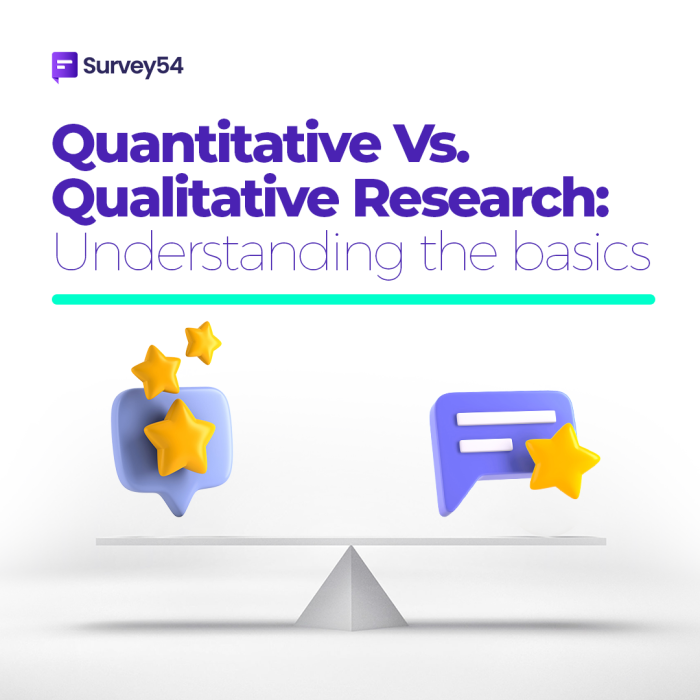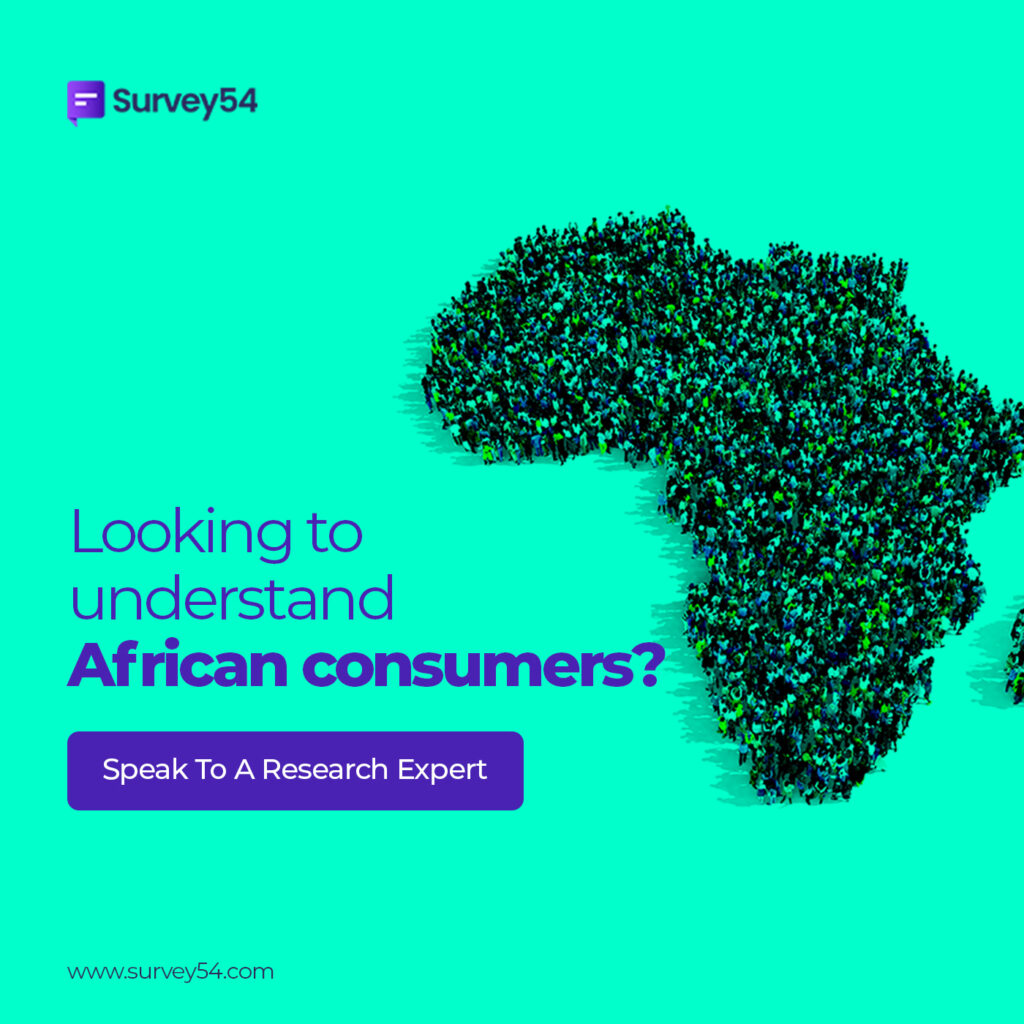Quantitative and qualitative research are alternative methodologies you can mix in your surveys to provide comprehensive and detailed data.
Quantitative data provides the numerical evidence needed to support the broad generalizations of your research. Qualitative data provides the specifics and depth necessary to comprehend their full ramifications.
It would help if you grasped their distinctions to maximize the results from these different survey methodologies. Let’s examine this.
What distinguishes quantitative research from qualitative research?
Quantitative research- Definition
The objective of quantitative research methods is to acquire numerical data that may be used to measure variables. Structured and statistical, quantitative data yields objective and unambiguous outcomes. It employs a grounded theory approach that focuses on systematic data collecting and analysis. Quantitative research is a process that assists when researchers need to draw general conclusions and forecast results from the study.
Surveys are an excellent instrument for quantitative research because they are economical, adaptable, and permit data collection from a vast sample size.
Qualitative research- Definition
Qualitative research is a technique employed to capture non-numerical data to gain understanding. It is non-statistical, unstructured, or partially structured. It depends on data collected according to a study design that addresses the “why” issue.
Qualitative data collection aims to characterize a topic rather than quantify it. This research measures opinions, perspectives, and characteristics as opposed to actual data shown in a graph or a chart.
Typically, qualitative research methods require direct observation, like interviews or focus groups. It is market research typically conducted in naturalistic environments, without using experiments or control groups.
Qualitative researchers aim to delve deeply into the topic at hand to learn about people’s motivations, thoughts, and attitudes. However, while qualitative methods provide richness to your research topics, they might make the results more challenging to assess.
The best times to use Qualitative Vs. Quantitative research
Quantitative data can aid in understanding the big picture. Qualitative data provides specificity and gives your survey results a human voice.
Let’s see how to implement each technique in a research project.
- To formulate a hypothesis: Qualitative research aids in gathering specific knowledge about a topic. You can utilize it as a starting point for your research by uncovering the issues or opportunities people are considering. These concepts can be developed into testable hypotheses through quantitative research.
- Verification of hypotheses: Quantitative research yields numbers to which statistical analysis can be applied to validate theories. Was this issue real or merely a person’s perception? You will be able to draw conclusions based on objective observations thanks to the collected data.
- Finding generic answers: Since it is simpler to run a multiple-choice survey than a set of interviews or focus groups, quantitative research typically has more participants than qualitative research. Therefore, it enables you to definitively answer broad queries such as, “Are you more popular than your competitors?” “Which of your company’s services is the most crucial?” “Which advertisement is the most appealing?” etc.
- Including the human factor: Qualitative research can also aid in the final stages of a project by incorporating the human element. The responses to open-ended questions can lend a human voice to the objective numbers and patterns collected from your research. Many times, hearing your consumers describe your business in their own words can help you identify blind spots. This is what qualitative data will provide.
How can you balance qualitative and quantitative research?
These two study approaches are compatible with one another. They perform far better as a team. In a world of Big Data, facts and numbers are abundant upon which your decisions can rest securely. However, this basis is insufficient without the data obtained from actual individuals, which gives meaning to the statistics.
So how can you combine these two types of research? Qualitative research is nearly always the beginning point when identifying new challenges and opportunities, facilitating a deeper study later. Quantitative data will provide measurements to confirm and comprehend each problem or opportunity.
How about an illustration?
Suppose you hosted a conference and solicited guest comments. Using quantitative research, you can likely already measure several variables, such as attendance, general satisfaction, speaker quality, informational value, etc. These questions can all be answered in a closed-ended and quantifiable manner.
But you may also want to include a few qualitative, open-ended research questions to see what you missed. For example, you might utilize queries like:
- What was your favorite aspect of the conference?
- How can we make your experience better?
- Are there any comments on the discussion that you believe we should be aware of?
Suppose you identify any recurring patterns through these qualitative questions. In that case, you can decide to conduct an additional study, modify your next event, and add quantitative questions on these subjects following the next conference.
Assume, for instance, that many conference attendees cited the difficult-to-reach location as their least favorite aspect. Next time, you may offer quantitative questions, such as how satisfied people were with the location, or provide them with a list of prospective venues from which to choose.
Open-ended vs. close-ended questions
Examining your open-ended questions and asking yourself why you are using them will help determine if you need to transition from one strategy to another.
For instance, if you asked, “What do you think of our ice cream prices?”. Respondents would provide feedback on their own terms, and you would likely receive unconventional responses.
If that’s not what you’re after, you should try choosing an easily quantifiable response. For instance:
“What do you feel about our ice cream prices compared to our competitors?”
- Higher
- Comparable
- Lower
This type of question will bring clarity to your survey respondents and yield consistent and straightforward data to evaluate.
How to acquire qualitative data
There are a variety of qualitative research methodologies that will yield fully detailed information about your area of interest.
- Interviews: In-depth, one-on-one discussions on the topic at hand.
- Case studies: Client narratives gathered from in-depth interviews.
- Expert opinions: Quality information from knowledgeable sources.
- Focus groups: Conversations with small groups of individuals in person or online to gather their opinions on a product or topic.
- Open-ended survey questions: A text area in a survey that allows respondents to express their thoughts on the topic at hand freely.
- Observational research: Observing people during their everyday routines to determine, for instance, how they engage with a product.
However, this research style does not always provide the most correct answers to the most important topics. And assessing the results is difficult because people will use different terms and phrases to explain their viewpoints and may not even discuss the same issues if they have the freedom to roam in their comments.
In certain circumstances, asking only quantitative questions may be more effective.
Why gather quantitative data?
Qualitative survey questions run the danger of being insufficiently specific.
To prevent confounding your responders, you might wish to avoid asking, “What do you think of our Internet service?” You may instead pose a closed-ended, quantitative question, such as the one shown below;
“How reliable is our Internet service?”
- Always
- Most frequently
- About half the time
- Occasionally
- Never
Answering qualitative questions takes more time.
Respondents to a survey do not always have the patience to consider the question and compose lengthy, well-thought-out responses carefully. In a questionnaire, selecting one of the numerous pre-loaded options is significantly quicker. Therefore, quantitative questions help you get more questions in your research and more responses.
Quantitative survey questions are merely more… measurable
Even word responses on closed-ended questionnaires can be allocated numerical values that can be converted into indicators and graphs later. This indicates that the overall data quality has improved. Remember that the most precise information leads to the finest decisions.
Examples of the application of qualitative and quantitative inquiry
Our mobile-led survey solution makes it effortless for you to comprehend how qualitative and quantitative questions can work in tandem to deliver a comprehensive perspective of the state of your business.
Quantitative questions:
How long have you been patronizing our business?
- This is my first acquisition.
- Approximately six months.
- Between six months and a year.
- 1-3 years.
- More than three years.
- I have not yet made a purchase.
How likely are you to purchase another of our products?
- Extremely likely
- Very likely
- Somewhat likely
- Not so likely
- Not at all likely
Additional qualitative inquiry:
Do you have any further comments, questions, or concerns?
Quantitative questions:
How frequently does your supervisor provide constructive feedback when you make a mistake?
- Always
- Most of the time
- About half of the time
- Occasionally
- Never
Qualitative question:
What steps does your supervisor need to take to improve their performance?
Conclusion
Now that you are familiar with the definitions of qualitative and quantitative data and the distinctions between these two research approaches, you can better comprehend how to combine them. You may put them to work for you on your next project using our self-serve survey template, designed to provide reliable real-time insights.
We assist businesses to grow and scale by providing timely and transparent audience insights from Africa and emerging markets.
With mobile-driven data collection methodologies and intelligent data, we bring you closer to your customers as an automated data platform.
Want to learn a little more from a research expert’s perspective on whether to start with a more quantitative or qualitative approach? Simply click to send an email to info@survey54.com


